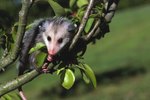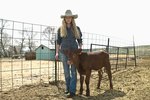
African greys are usually attentive parents, but occasionally a clutch is abandoned and hand-feeding becomes necessary. An ill bird can also require hand-feeding. Hand-feeding an African grey parrot isn't difficult, with proper training and a little experience. To be prepared for an emergency when breeding African greys, ask your avian veterinarian or a reputable breeder for hands-on training before the eggs begin hatching.
Properly Prepared Formula Is Essential
Leave the baby in his nest or brooder while you clean and disinfect the preparation area, wash and dry your hands and prepare the formula. Mix warm bottled water with powdered formula, using a commercial baby parrot formula specifically formulated for African greys. Never heat prepared formula in a microwave; hot spots can burn the chick. Follow the manufacturer's directions carefully; dilution rates and feeding schedules vary according to the chick's age. Malnutrition, dehydration or an impacted crop are some of the problems that improperly diluted formula may cause.
Keep the Formula Warm
Use a thermometer to ensure the formula is between 103 and 108 degrees Fahrenheit, leaving it in the food during feeding. To keep the formula at the proper temperature, lower the feeding container into a bowl of very warm water. Stir the formula and check its temperature each time you fill the feeding syringe. Proper food temperature is crucial for healthy weight gain.
Initiate a Feeding Response
Keep your chick warm and away from drafts while feeding him. Gently touch the soft pad at the inner edge of his beak with the filled feeding syringe to initiate a feeding response. When the chick opens his beak, angle the syringe behind his tongue, toward the back or sides of his throat, avoiding the windpipe located in the center of his throat. Slowly depress the syringe while the crop, a pouch on the front of the chick's throat, plumps up. Don't allow the crop to overflow.
Clean the Chick After Feeding
Baby parrots are messy eaters, and must be cleaned immediately after being fed. Using a cotton swab moistened with warm water, thoroughly clean inside the beak. Any food particles stuck here can turn sour, which may cause a bacterial infection. Carefully clean his face with a soft, moist cloth. Even his nostrils may contain caked formula. Dry him thoroughly, and replace him in his brooder or nest to avoid a chill.
Allow His Crop to Completely Empty
An African grey chick's crop must empty at least once each day. Failure to allow emptying of the crop may result in sour crop and bacterial infections, the two most common problems seen in hand-fed chicks. Let the chick go unfed for seven hours overnight, which allows the crop to empty completely. Other potential problems include malnutrition, pneumonia caused by aspirated formula and health or behavioral problems caused by early weaning.
References
Photo Credits
-
Hemera Technologies/PhotoObjects.net/Getty Images
Writer Bio
Karen Mihaylo has been a writer since 2009. She has been a professional dog groomer since 1982 and is certified in canine massage therapy. Mihaylo holds an associate degree in human services from Delaware Technical and Community College.




